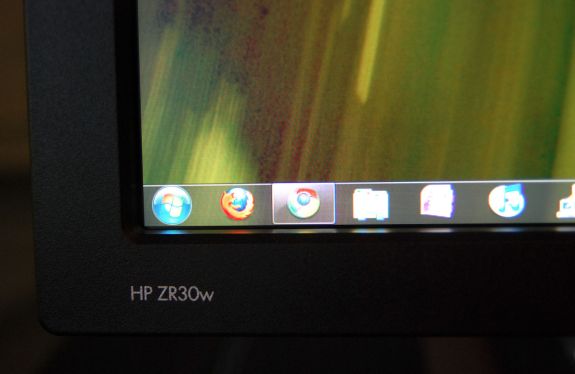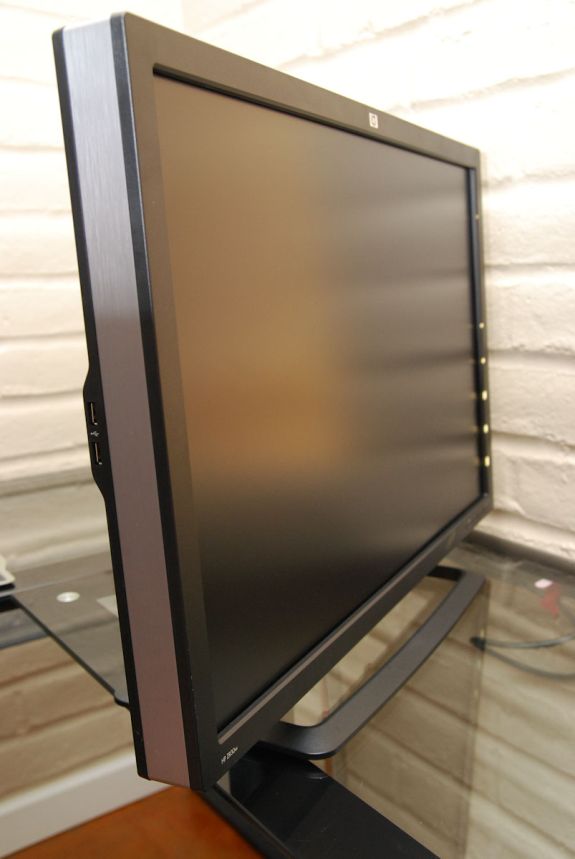A New 30" Contender: HP ZR30w Review
by Brian Klug on June 1, 2010 6:30 PM EST
Opining for an OSD
As I mentioned before, there’s no OSD to speak of. The only options exposed to users are input selection, brightness, and dynamic contrast. A blue LED at right flashes three times when you’ve reached the upper or lower brightness limits, and flashes four times when dynamic contrast is turned on, once when turned off. The LED is off when the display is in operation, and amber when in standby. The rest is up to you.
Spartan Scaling Selections
I also already touched on scaling which appears to be pretty barebones for reasons discussed earlier. You can pixel double by going with 1280x800, or go for native, or choose another resolution and everything upscaled with some smudging. There's no 1:1 option, or any options whatsoever. Honestly, I can’t think of any reasons why you wouldn’t drive an LCD at anything other than native resolution. The dot pitch of the ZR30w is fabulous at 0.250 mm, if you’re paying for those pixels, use them, then use DPI controls in the operating system if text and UI is too small. The ZR30w does scale other aspect ratios that I tested properly, but don't expect too much. Honestly it still makes no sense to drive a display this high resolution at anything but native.
Final Thoughts
The 30” segment of the LCD market demands the best of the best. It’s indisputably the ring in which every manufacturer wages battle with its flagship monitor. Solid execution here usually translates to solid performance for smaller size panels in the same lineup. Suffice it to say that HP’s 30 inch ZR series successor to the LP3065 doesn’t disappoint.
Spartan Scaling Selections
I also already touched on scaling which appears to be pretty barebones for reasons discussed earlier. You can pixel double by going with 1280x800, or go for native, or choose another resolution and everything upscaled with some smudging. There's no 1:1 option, or any options whatsoever. Honestly, I can’t think of any reasons why you wouldn’t drive an LCD at anything other than native resolution. The dot pitch of the ZR30w is fabulous at 0.250 mm, if you’re paying for those pixels, use them, then use DPI controls in the operating system if text and UI is too small. The ZR30w does scale other aspect ratios that I tested properly, but don't expect too much. Honestly it still makes no sense to drive a display this high resolution at anything but native.
Final Thoughts
The 30” segment of the LCD market demands the best of the best. It’s indisputably the ring in which every manufacturer wages battle with its flagship monitor. Solid execution here usually translates to solid performance for smaller size panels in the same lineup. Suffice it to say that HP’s 30 inch ZR series successor to the LP3065 doesn’t disappoint.
We would’ve liked to see just a bit more color accuracy, but the tradeoff for a dramatically bigger gamut is a good one to make. The ZR30w blew past the advertised 99% of AdobeRGB, coming in at just over 111% of the volume. It’s important to note that HP likely means coverage overlap of 99%, which the ZR30w does meet. But heck, having a volume bigger than the AdobeRGB volume is more notable. In person, the ZR30w is impressive all around. It’s bright, contrasty, and has colors that put my daily use monitors and others I’ve got laying around to shame; not an easy thing to do.
At an MSRP of $1,299, the ZR30w is priced aggressively and below its predecessor and competition. If you don’t mind lacking an extra DVI port, the increase in gamut volume is a notable difference. It’s likely that both lack of an OSD as well as accessory VGA, HDMI, component or composite inputs is related to the lack of a compatible control IC. Instead, there’s likely a simple scaler so we see minimal processing lag for an IPS panel, and unfortunately minimal user control. This is a bold move on HP’s part to continue for a second generation, but likely keeps cost and input processing lag low.
At an MSRP of $1,299, the ZR30w is priced aggressively and below its predecessor and competition. If you don’t mind lacking an extra DVI port, the increase in gamut volume is a notable difference. It’s likely that both lack of an OSD as well as accessory VGA, HDMI, component or composite inputs is related to the lack of a compatible control IC. Instead, there’s likely a simple scaler so we see minimal processing lag for an IPS panel, and unfortunately minimal user control. This is a bold move on HP’s part to continue for a second generation, but likely keeps cost and input processing lag low.
Interestingly enough, this is definitely the way that things are going for display controls, with a growing number offering DDC control as the exclusive option for tweaking settings. In practice, what HP offers with the front controls is almost all you need, so long as you can calibrate to your liking in software. Perhaps we might have gotten under a Delta E of 1.0 with some RGB sliders, but who’s to say?
The ZR30w is definitely a serious contender among 30” displays. It’s an attractive package that wows with above average color tracking, an impressive gamut, and a competitive price, but lacks some of the extra “accessory” inputs that consumers are starting to demand. That said, it looks like the ZR30w is a solid option if you’re looking for a 30” display with an unbeatable color gamut.












95 Comments
View All Comments
mcklevin - Monday, June 28, 2010 - link
I now have had this monitor for a week, and it has performed quite well, it is a very solid professional looking build. The anti-glare screen does not sparkle like the LG screen, and the black levels are better as well. Text looks much better than the LG too.Right now I do not have a calibrator. The color accuracy is pretty good, It does get hot it the high end like many of the wide gamut monitors. Dropping the digital vibrancy to 44 in the nvidia control panel has helped a lot with the saturation. The viewing angles are nice, horizontal I would give an 9, vertical 7. I didn't notice input lag in Mass Effect 2. I use this monitor for Cinema 4D and Aftereffects.
AlphaJarmel - Wednesday, June 23, 2010 - link
So this monitor is pretty much useless for gaming as Windows will ignore the calibration.SoCalRich - Thursday, July 1, 2010 - link
Brian,Thanks for your review!!!
I have a new 17" MacBook Pro i7. I was curios if you were able to hook up your MBP to this monitor using the displayport cable?
I think this would be a great monitor for my Photoshop & Lightroom editing. I've been looking at the 30" ACD. This looks like a better monitor.
I'm still a little confused about how you make any adjustments w/o OSD????
SoCalRich - Thursday, July 1, 2010 - link
My new 17" MacBook Pro i7 uses the Intel HD Graphics for regular web surfing etc. It then switches to the NVIDIA GeForce GT 330M when I open Photoshop and Lightroom.I'm hoping these cards will support this monitor using the displayport cable.
tsittard - Saturday, July 3, 2010 - link
I picked this monitor up for a 3rd editing monitor to be used with Final Cut Pro, AJA Kona 3 card, and a blackmagic conversion box that goes from HD-SDI to dual link dvi-d.Here's the link:
http://www.blackmagic-design.com/products/hdlink/t...
I'm not getting any picture....
I'm currently using the zr30w as a second computer monitor, which is working fine at 2500x1600 coming off my Mac Pro, but this is not what I intended...
Is it not possible to send this monitor a 1920x1080 signal via dvi-d and have it upscale to fill it?
I'm also using 2 hp zr24w's for my computer monitors, and I've hooked up the blackmagic box to one of those and everything works great...
My settings inside of FCP are for a 1080 23.98psf 10bit signal, again it seems to work fine going into the ZR24w
I sense that there should be a simple answer here but I'm not finding it....
the blackmagic converter box also comes in a display port version, will that allow me to send the HD resolution to the zr30w?
Mr. Klug, any suggestions?
B3an - Tuesday, August 10, 2010 - link
Brian - you mentioned you used to i1 Display 2 to calibrate this monitor, i have both this monitor and the i1D2, can you tell me what settings you used?I find if a default white point is not selected then the colours and especially greys have a red tint to 'em. Did you try it with the Eye-One Match 3 software that comes with the i1D2? Thanks.
humba - Sunday, August 15, 2010 - link
Has anyone who actually got the monitor noticed a buzzing/humming noise coming from the screen as soon as there's a video input signal?The noise is similar to the feedback noise you get on an audio system if there's an issue with the grounding, and it only goes away if the brightness is increased to 80% or higher.
I've already RMA'ed my device once (they sent out a replacement only hours after receiving the case which makes me thing it's a known defect), but the replacement exhibits the exact same behavior. I've gone through a bunch of different DP cables, tried with various DVI cables, too, on 4 different computers (HP EliteBook 8540p, Acer Timelize 3810TZ, Mac Mini 2009 and a self-assembled box) and went around the house trying different electrical phases but to no avail.
And I seem not to be the only one since I found this test that mentions the same issue: http://www.productwiki.com/hp-zr30w/. And, strangely enough, the support documents at HP's site also has a support document (albeit a very old one ): http://h20000.www2.hp.com/bizsupport/TechSupport/D... which doesn't really have any relation to the display in question other than the 80% brightness mentioned which seems to be the fix from 2003 on.
martinz - Tuesday, November 1, 2011 - link
Yes. Mine did it, got it replaced, same issue.HP in the US confirmed they all do it below 80% brightness, but tried to claim all/most large panels do it.
I think it is completely unacceptable for a monitor at this price - and I am shocked that HP don't agree. Otherwise, I like it a lot: great picture and build quality.
In a busy office it would not be noticeable, and if you can live with the (for me) eyeball melting full brightness, or are not sensitive to ambient noise, it's not an issue either.
For me it's a show stopper. Mine is going back, but not sure what to replace it with.
BikeDude - Friday, August 27, 2010 - link
Do all displays support HDCP these days, or will I still need AnyDVDHD in the future if I have to replace my current 30" Apple Cinema display?fontajos - Monday, September 13, 2010 - link
Hi Brian,thanks for your extensive test on the HP Z30w. I just bought the z30w and was very disappointed by the strong blue at 9000 Kelvin. I installed the hp ICM profile but nothing changed. I want to have a 6500K screen (like all other monitors here). Is it possible to send me your ICM file or can you suggest me a way to get my white to real-white and not blueish-white? If the only solution is to use a hardware calibration, can you suggest me a product?